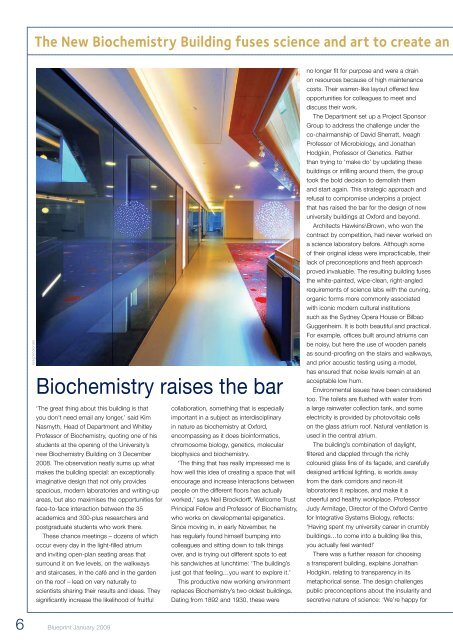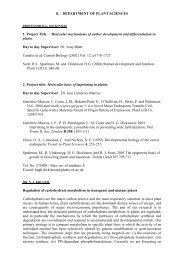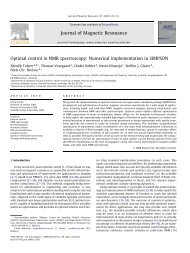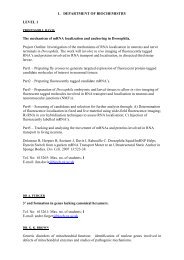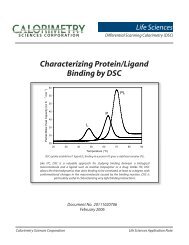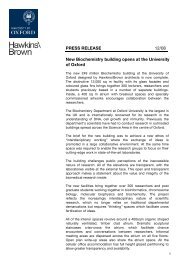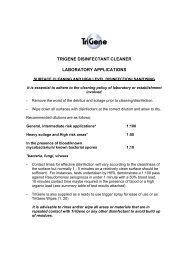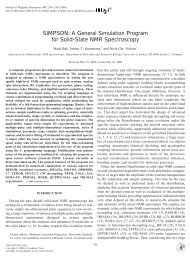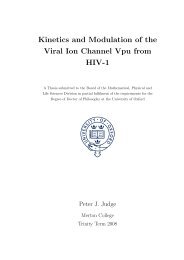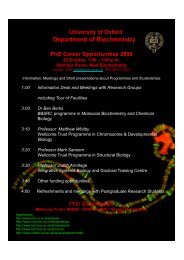Beautiful Biochemistry Educating the workers - Department of ...
Beautiful Biochemistry Educating the workers - Department of ...
Beautiful Biochemistry Educating the workers - Department of ...
Create successful ePaper yourself
Turn your PDF publications into a flip-book with our unique Google optimized e-Paper software.
The New <strong>Biochemistry</strong> Building fuses science and art to create an<br />
Greg Smolonski<br />
<strong>Biochemistry</strong> raises <strong>the</strong> bar<br />
‘The great thing about this building is that collaboration, something that is especially<br />
you don’t need email any longer,’ said Kim important in a subject as interdisciplinary<br />
Nasmyth, Head <strong>of</strong> <strong>Department</strong> and Whitley in nature as biochemistry at Oxford,<br />
Pr<strong>of</strong>essor <strong>of</strong> <strong>Biochemistry</strong>, quoting one <strong>of</strong> his encompassing as it does bioinformatics,<br />
students at <strong>the</strong> opening <strong>of</strong> <strong>the</strong> University’s chromosome biology, genetics, molecular<br />
new <strong>Biochemistry</strong> Building on 3 December biophysics and biochemistry.<br />
2008. The observation neatly sums up what ‘The thing that has really impressed me is<br />
makes <strong>the</strong> building special: an exceptionally how well this idea <strong>of</strong> creating a space that will<br />
imaginative design that not only provides encourage and increase interactions between<br />
spacious, modern laboratories and writing-up people on <strong>the</strong> different floors has actually<br />
areas, but also maximises <strong>the</strong> opportunities for worked,’ says Neil Brockdorff, Wellcome Trust<br />
face-to-face interaction between <strong>the</strong> 35 Principal Fellow and Pr<strong>of</strong>essor <strong>of</strong> <strong>Biochemistry</strong>,<br />
academics and 300-plus researchers and who works on developmental epigenetics.<br />
postgraduate students who work <strong>the</strong>re. Since moving in, in early November, he<br />
These chance meetings – dozens <strong>of</strong> which has regularly found himself bumping into<br />
occur every day in <strong>the</strong> light-filled atrium colleagues and sitting down to talk things<br />
and inviting open-plan seating areas that over, and is trying out different spots to eat<br />
surround it on five levels, on <strong>the</strong> walkways his sandwiches at lunchtime: ‘The building’s<br />
and staircases, in <strong>the</strong> café and in <strong>the</strong> garden just got that feeling…you want to explore it.’<br />
on <strong>the</strong> ro<strong>of</strong> – lead on very naturally to<br />
This productive new working environment<br />
scientists sharing <strong>the</strong>ir results and ideas. They replaces <strong>Biochemistry</strong>’s two oldest buildings.<br />
significantly increase <strong>the</strong> likelihood <strong>of</strong> fruitful Dating from 1892 and 1930, <strong>the</strong>se were<br />
no longer fit for purpose and were a drain<br />
on resources because <strong>of</strong> high maintenance<br />
costs. Their warren-like layout <strong>of</strong>fered few<br />
opportunities for colleagues to meet and<br />
discuss <strong>the</strong>ir work.<br />
The <strong>Department</strong> set up a Project Sponsor<br />
Group to address <strong>the</strong> challenge under <strong>the</strong><br />
co-chairmanship <strong>of</strong> David Sherratt, Iveagh<br />
Pr<strong>of</strong>essor <strong>of</strong> Microbiology, and Jonathan<br />
Hodgkin, Pr<strong>of</strong>essor <strong>of</strong> Genetics. Ra<strong>the</strong>r<br />
than trying to ‘make do’ by updating <strong>the</strong>se<br />
buildings or infilling around <strong>the</strong>m, <strong>the</strong> group<br />
took <strong>the</strong> bold decision to demolish <strong>the</strong>m<br />
and start again. This strategic approach and<br />
refusal to compromise underpins a project<br />
that has raised <strong>the</strong> bar for <strong>the</strong> design <strong>of</strong> new<br />
university buildings at Oxford and beyond.<br />
Architects Hawkins\Brown, who won <strong>the</strong><br />
contract by competition, had never worked on<br />
a science laboratory before. Although some<br />
<strong>of</strong> <strong>the</strong>ir original ideas were impracticable, <strong>the</strong>ir<br />
lack <strong>of</strong> preconceptions and fresh approach<br />
proved invaluable. The resulting building fuses<br />
<strong>the</strong> white-painted, wipe-clean, right-angled<br />
requirements <strong>of</strong> science labs with <strong>the</strong> curving,<br />
organic forms more commonly associated<br />
with iconic modern cultural institutions<br />
such as <strong>the</strong> Sydney Opera House or Bilbao<br />
Guggenheim. It is both beautiful and practical.<br />
For example, <strong>of</strong>fices built around atriums can<br />
be noisy, but here <strong>the</strong> use <strong>of</strong> wooden panels<br />
as sound-pro<strong>of</strong>ing on <strong>the</strong> stairs and walkways,<br />
and prior acoustic testing using a model,<br />
has ensured that noise levels remain at an<br />
acceptable low hum.<br />
Environmental issues have been considered<br />
too. The toilets are flushed with water from<br />
a large rainwater collection tank, and some<br />
electricity is provided by photovoltaic cells<br />
on <strong>the</strong> glass atrium ro<strong>of</strong>. Natural ventilation is<br />
used in <strong>the</strong> central atrium.<br />
The building’s combination <strong>of</strong> daylight,<br />
filtered and dappled through <strong>the</strong> richly<br />
coloured glass fins <strong>of</strong> its façade, and carefully<br />
designed artificial lighting, is worlds away<br />
from <strong>the</strong> dark corridors and neon-lit<br />
laboratories it replaces, and make it a<br />
cheerful and healthy workplace. Pr<strong>of</strong>essor<br />
Judy Armitage, Director <strong>of</strong> <strong>the</strong> Oxford Centre<br />
for Integrative Systems Biology, reflects:<br />
‘Having spent my university career in crumbly<br />
buildings…to come into a building like this,<br />
you actually feel wanted!’<br />
There was a fur<strong>the</strong>r reason for choosing<br />
a transparent building, explains Jonathan<br />
Hodgkin, relating to transparency in its<br />
metaphorical sense. The design challenges<br />
public preconceptions about <strong>the</strong> insularity and<br />
secretive nature <strong>of</strong> science: ‘We’re happy for<br />
6<br />
Blueprint January 2009


